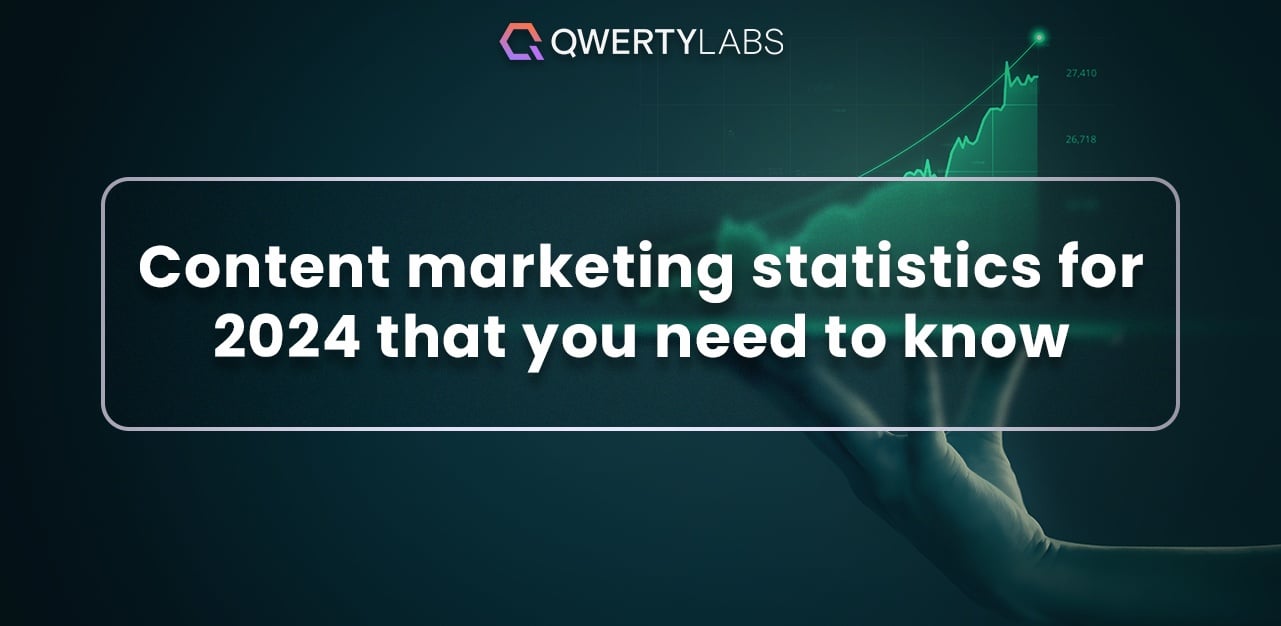Engage your audience with the right brand event marketing strategy. Discover tips and tricks to create impactful events with QWERTYLABS.

In content marketing, industry developments are fast-paced, and the overall landscape is ever-changing. As a marketer, staying updated with the latest content marketing statistics is your key to success. It’s crucial to adapt to evolving content marketing trends, technology, and tactics and embrace the dynamic nature of this field. By exploring the content marketing trends of 2024 and its best practices for application, you can unlock the potential for growth and engagement in your content marketing strategies.
Discover how to leverage content marketing stats effectively and gain a competitive edge with QWERTYLABS!

Understanding the basics of content marketing is vital for building a successful marketing strategy in today's digital marketing scene. It is a strategic approach focusing on creating and distributing valuable, relevant, and consistent content to attract and engage a specific target audience.
Unlike traditional marketing techniques that solely promote products or services, content marketing aims to provide value to the audience by giving information, entertainment, or solutions to their problems. The emphasis is on creating high-quality content that resonates with the audience. This content can take various forms, such as blog posts, videos, infographics, podcasts, or social media posts.
The key is to deliver helpful, informative content that aligns with the reader's or user's interests and needs. By adopting a strategic approach to content marketing, you can nurture relationships with your target audience, establish yourself as a credible industry leader, and drive profitable customer action.

Gathering content marketing data for 2024 is crucial to gain insight into effective and impactful strategies for your content marketing efforts during the year. These data offer valuable details regarding various metrics, such as engagement rates, conversion rates, return on investment (ROI), and emerging trends.
Here are various content marketing statistics you should pay attention to for better marketing strategies:
Content marketing usage increased from 70% in 2020 to 82% in 2024. This increase shows its continued relevance and impact to a brand’s success. Content marketing is being adopted by more firms than ever before, leading to increased brand visibility and lead conversion. So, if you still need to embrace content marketing, now is the perfect time to tap into its host of benefits and stay ahead of the competition.
On average, individuals now spend around 7 hours per day consuming content, which has more than doubled from the previous average of just over 3 hours in 2020. This great increase reflects the growing demand for content and highlights the chance for businesses to meet this demand through content creation.
In the majority, 79% of content marketers use content marketing to produce high-quality leads. This finding stresses that lead generation is the top priority for content marketers, followed by driving website traffic and enhancing brand reputation.
While the 51% rating indicates the overall success of the marketing efforts, only 11% rate their performance as 'excellent'. This suggests there is still room for improvement when developing content marketing strategies for better results.
SEO or Search Engine Optimisation is integral to a successful content marketing strategy. It’s a useful tool that improves visibility and generates organic search traffic to provide opportunities for lead conversion.
This statistic highlights the value of constantly reviewing and refining existing content on your platform. This improves its relevance and maximises its performance on search engine result pages (SERPs). When this is done, you allow your brand to reach new audiences with improved content, showcasing your authority on industry-related topics.
Organic search remains the most popular channel for content distribution, with 89% of companies distributing their content through this method. Leveraging organic search involves ensuring content is indexed and enhanced for search engine rankings. Social media distribution is closely behind at 87%, another great channel for releasing content.


SEO and content marketing work together to improve visibility and drive organic traffic from search engines. SEO focuses on improving websites and their content to rank higher in search engine results, boosting visibility to the target audience. Conversely, content marketing involves creating valuable and relevant content that aligns with the target audience's needs and interests.
The successful combination of SEO and content marketing ensures that high-quality content is discoverable by search engines, leading to improved visibility and increased organic traffic to the website. To help in this, we’ve gathered data from reliable sources such as Ahrefs and Semrush. Based on their analyses, here is the organic search data you must know:

Marketing data within the vast social media space shows the importance of utilising social media platforms in your marketing strategy. Platforms such as Facebook, Instagram, and Twitter dominate the social media landscape, with billions of active users you can reach. That’s why leveraging social media is a key component of an effective marketing strategy. In line with this, here are the crucial social media marketing statistics you need to know:

Blogging statistics show the importance of creating high-quality, optimised blog posts in content creation. Creating high-quality content, such as blog posts, is crucial in attracting and engaging readers. This contributes to proving your authority in the industry and driving organic traffic to a website. When making content, you should utilise relevant keywords and SEO techniques to help improve search engine rankings and visibility. This is an effective marketing strategy to raise brand awareness, generate leads, and nurture customer relationships.
Here are some of the interesting content creation statistics for bloggers:
Video marketing data highlight the importance of creating attention-grabbing videos to convey brand messages effectively and increase brand awareness. Video content has become a powerful tool in content marketing, as it captures and retains viewer attention more than other forms of content.
Analysing video content marketing data provides valuable insights into audience engagement, likes, and trends, enabling you to improve your strategies for maximum impact.
Here are the important statistics you should know to create an effective video marketing strategy:
B2B content marketing data shows how tailored messaging and addressing the specific interests of business-to-business audiences are crucial. B2B content marketing aims to provide helpful and relevant information that resonates with the needs and challenges of other businesses, establishing credibility and trust. Scanning relevant statistics helps you understand the preferences and the B2B consumer’s interests, enabling you to create effective marketing plans that deliver targeted messages and drive business growth.
Here are content marketing data on content marketing for B2B and B2C:
The content marketing statistics for 2024 reveal the key factors for success in this changing landscape. Understanding and grasping the latest trends, such as the dominance of video content, the importance of tailored messaging in B2B marketing, the impact of organic search in driving blog traffic, and more, can greatly boost your marketing efforts.
You can refine your marketing plans and improve your content performance by monitoring and analysing our data. However, if you're looking to stay ahead in the dynamic world of content marketing, our services at QWERTYLABS are here to help you navigate these trends and achieve your marketing goals.
Get in touch with us now to discover the full range of our digital marketing services and how they can benefit your business.
Content marketing statistics for 2024 reveal that companies' adoption of content marketing has increased by 82%, up from 70% in 2020. Marketers are now heightening their focus on generating high-quality leads and on creating valuable and consistent content to meet the growing demand. They leverage SEO tactics, repurpose existing content, and distribute it through organic search and social media channels.
AI is becoming integral to content creation because it offers several benefits, including automation, efficiency, and personalisation. AI-powered tools can create content at scale, improving it for search engines and tailoring it to individual user interests, making the content creation process more streamlined and effective.
The future of content marketing is expected to be more immersive and interactive. Emerging technologies like virtual reality, augmented reality, and interactive content formats will play a huge role in engaging audiences and delivering more personalised experiences. Additionally, content will continue to evolve to meet the changing preferences and behaviours of consumers, with a greater emphasis on authentic storytelling and purpose-driven messaging.
Video marketing can boost brand visibility through creative visuals that capture audience attention more effectively than other content formats. Videos have the potential to go viral, reach a wide audience, and create emotional connections with viewers. They can be shared across various platforms and social media channels, enhancing brand exposure and increasing the likelihood of engagement and conversions.

 A guide to proper brand event marketing to elevate your business
A guide to proper brand event marketing to elevate your business
Engage your audience with the right brand event marketing strategy. Discover tips and tricks to create impactful events with QWERTYLABS.
 Cybersecurity trends 2024: What online casinos should know
Cybersecurity trends 2024: What online casinos should know
Stay on top of your site's cyber security by learning trends like Zero Trust Security and Supply Chain Attacks. Learn more about it at QWERTYLABS.
 The latest Google search algorithm updates for SEO success
The latest Google search algorithm updates for SEO success
In 2024, Google remains the top choice for finding answers online. That’s why it continuously refines its search policies and algorithms to improve user experience (UX) and provide more accurate search results.
8F, One Trium Tower,
Filinvest Avenue, Alabang, Muntinlupa, Metro Manila
Philippines, 1799
[email protected]
+63 (02) 8971 8926